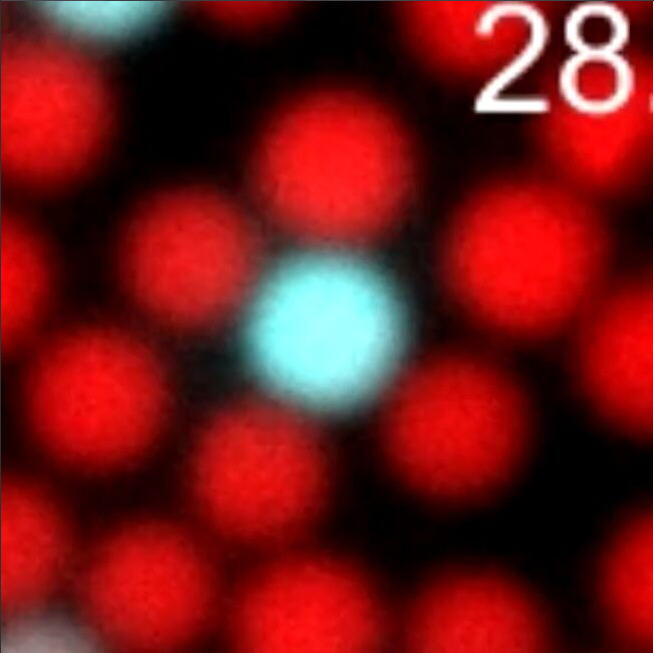博文
物理学家发现粒子是如何自我组装的
 精选
精选
||
物理学家发现粒子是如何自我组装的
诸平
据美国纽约大学(New York University简称NYU)2021年11月1日提供的消息,一组物理学家发现了DNA分子是如何根据组装指令自组织成粒子之间的粘附斑块的(Physicists discover how particles self-assemble)。它的发现为一种创新方法提供了“概念证明(proof of concept)”,这种方法可以生产出粒子之间具有明确连接性的材料。这项研究已经在《美国国家科学院院刊》(Proceedings of the National Academy of Sciences)网站发表——Angus McMullen, Sascha Hilgenfeldt, Jasna Brujic. DNA self-organization controls valence in programmable colloid design. Proceedings of the National Academy of Sciences (2021). DOI: 10.1073/pnas.2112604118. 但在此之前(2021年9月2日)已经在预印本文库网站发表(arXiv:2109.01171.[Submitted on 2 Sep 2021] )
纽约大学物理系教授、上述论文的研究者之一Jasna Brujic解释说:“我们证明,可以对粒子进行编程,使其具有定制的属性,形成定制的结构。在建造建筑时,起重机、钻头和锤子必须由人类控制,而这项工作揭示了如何利用物理学来制造‘知道’如何组装自己的智能材料(smart materials)。”
科学家们长期以来一直在寻找分子自我组装的方法,并在许多方面取得了突破。然而,这些微小粒子自组装与预先编程的键的数量测量尚不成熟。为了解决这个问题, Jasna Brujic和她的同事们, 纽约大学物理系博士后安格斯·麦克马伦(Angus McMullen)以及伊利诺伊大学香槟分校(University of Illinois, Urbana-Champaign)机械科学与工程教授萨沙·希尔根费尔特(Sascha Hilgenfeldt)进行了一系列的实验来捕获和操纵DNA分子在粒子表面的行为。
纽约大学物理系安格斯·麦克马伦提供的相关视频显示,一个蓝色粒子最初与三个红色粒子结合,在室温下满足其价态。加热时,这些键就会断开,但冷却后,粒子又会找到三个红色的伙伴,这表明粒子选择了它所形成的键的数量。他们的结果表明,粒子之间的DNA键是可逆的,并在粒子表面重新排列以优化价。
他们在微米级的水平上操作只有尘埃大小的1/25的微粒,将微小的水滴浸入液体溶液中。附着在这些液滴上的是“DNA连接器(DNA linkers)”即分子工具(molecular tools),它们具有“粘性末端(sticky ends)”,可以混合和匹配,形成研究人员想要的一系列结构。
Jasna Brujic说:“这个过程的美妙之处在于,我们可以对特定材料的属性进行编程,使其具有弹性或脆性,甚至在断裂后具有自愈能力,因为键是可以形成和断裂的,而且是可逆的。造物主可以决定放入5个粒子,其中仅有一个粘附另外一个,也可以放入10个粒子,仅是2个粒子与另外1个粒子粘附;还可以放入20个粒子,只有3个粒子与另外1个粒子粘附或者其他任何组合。这将允许您构建具有特定拓扑或架构的材料。”
上述介绍,仅供参考。欲了解更多信息,敬请注意浏览原文或者相关报道。
http://dx.doi.org/10.1073/pnas.2112604118
https://arxiv.org/abs/2109.01171
https://arxiv.org/pdf/2109.01171.pdf
Just like atoms combine into molecules, colloids can self-organize into predetermined structures according to a set of design principles. Controlling valence -- the number of inter-particle bonds -- is a prerequisite for the assembly of complex architectures. The assembly can be directed via solid `patchy' particles with prescribed geometries to make, for example, a colloidal diamond. We demonstrate here that the nanoscale ordering of individual molecular linkers can combine to program the structure of microscopic assemblies. Specifically, we experimentally show that covering initially isotropic microdroplets with N mobile DNA linkers results in spontaneous and reversible self-organization of the DNA into Z(N) binding patches, selecting a predictable valence. We understand this valence thermodynamically, deriving a free energy functional for droplet-droplet adhesion that accurately predicts the equilibrium size of and molecular organization within patches, as well as the observed valence transitions with N. Thus, microscopic self-organization can be programmed by choosing the molecular properties and concentration of binders. These results are widely applicable to the assembly of any particle with mobile linkers, such as functionalized liposomes or protein interactions in cell-cell adhesion.
https://blog.sciencenet.cn/blog-212210-1310642.html
上一篇:模型显示10亿人可以从假设的采集设备中获得安全的饮用水
下一篇:[转载]梦遇兵圣,孙子四字点评囚徒困境
